In 2013, an unknown company called Xitogen set up a booth at the annual CYTO conference. Before long, there was a buzz racing through the exhibit floor aisles of a flow cytometer starting at ~US$25,000 (1 laser, 2 colors). The Chinese company, headquartered in the Suzhou Industrial Park, set out to provide an alternative for Chinese researchers to acquire affordable flow cytometry instrumentation without having to deal with overpriced imported hardware from the big players. With U.S. zero install base, and zero user-generated data, CYTO 2013 came and went, and the buzz surrounding Xitogen died out. It was pretty obvious the better known cytometer manufacturers would be taking a look at the company for a possible acquisition, and in April of 2014, Beckman Coulter announced they would purchase Xitogen for an undisclosed amount of money. The acquisition was finalized in June 2014. At CYTO2014, Beckman Coulter revealed the re-branded instrument now called CytoFLEX.
I had the chance to spend about a month with the CytoFLEX and what follows are some of my thoughts about the key features, successes and failures of this instrument.
General Technical Specs:
The CytoFLEX came to me as a 3 laser system including a 50mW 488nm laser, a 55mW 640nm
laser, and a 93mW 405nm laser. The system also has 9 fluorescence channels in a 4-3-2 configuration, respectively. In addition, there are 3 light scatter parameters, the typical blue laser scatter yielding forward and side scatter, and an additional side scatter parameter off the 405nm laser. Pulse height and area are collected for all parameters, and a width signal can be selected for any one of the parameters. The fluidics system is controlled through peristaltic pumps for both the sheath and sample lines, and the sample volume flow rates can range from 10ul/min up to 240ul/min with 10, 30, and 60 ul/min presets (referred to as Low, Med, and Hi, respectively). A single tube holder with built-in backflush loads samples into the instrument one-at-a-time, and the hardware is controlled by the bare bones, but highly functional CytExpert acquisition software.
The system that is suppose to ship some time in October will be configurable with 3 spatially separated lasers (with a 4th coming soon?), with a variety of laser options and colors available. The base configuration should include 3 lasers, and 13-colors in a 5-5-3 config (violet, blue, red, respectively).
 |
| Beckman Coulter CytoFLEX Analyzer |
The system that is suppose to ship some time in October will be configurable with 3 spatially separated lasers (with a 4th coming soon?), with a variety of laser options and colors available. The base configuration should include 3 lasers, and 13-colors in a 5-5-3 config (violet, blue, red, respectively).
Look and feel:
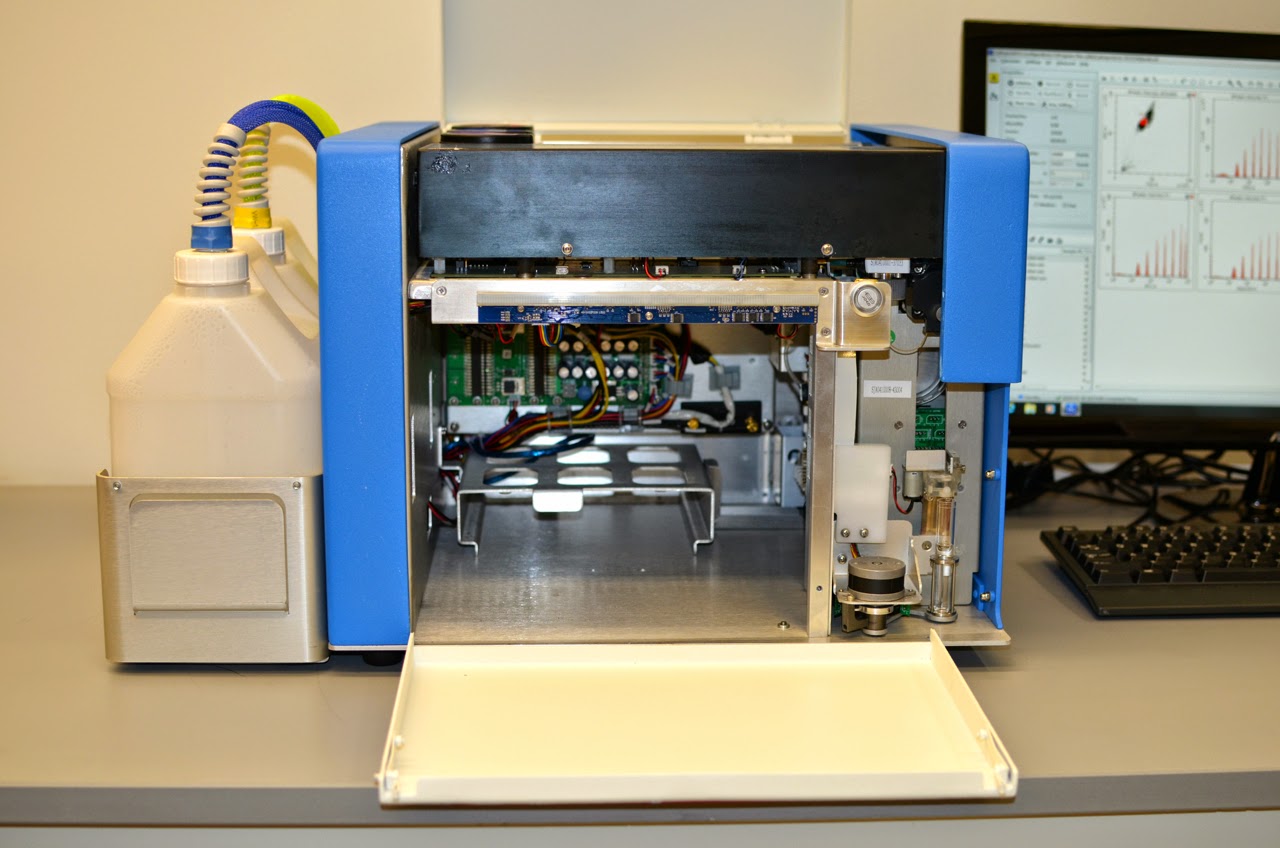 |
| A look inside the CytoFLEX revealing lots of unused space. |
Fluidics:
The Sheath and Waste tanks sit beside the instrument and have a single output/input line, respectively. They hold about 5 liters, which should last most of a day with moderate use and reasonable amounts of backflushing. The preferred sheath for this system is some high quality H2O (Insert Waterboy reference here). Beckman Coulter will likely sell you a box of water at a premium and call it "Coulter Sheath" but you'll be just fine grabbing some DI from your MilliQ system.
Again the system moves fluid throughout using a pair of peristaltic pumps. The non-fluid movement of peristaltic pumps tend to make them not ideal for a system that requires stable fluid flow, but in testing the CytoFLEX, I saw no fluctuations in any of the channels over long runs with beads (plotting bead intensity vs. time). This type of instability due to peristaltic pump oscillation had been reported in some iterations of the Accuri C6 when it first came out. In the CytoFLEX, special attention was paid to create a pulseless peristaltic pump, which definitely holds true in my testing.
Although the sample volume flow rate has a custom setting that allows it to go up to 240ul/min, in
my tests, I saw dramatic declines in scatter profiles and less obvious, but still present, losses in resolution of fluorescence profiles beyond 100ul/min. I think the 240 setting would be great for cleaning the sample line out, or maybe forcing through a stubborn clog, but not for collecting data. This type of flow rate is pretty much on par with other hydrodynamically focused fluidics system (unlike, for example the Attune that uses acoustic focusing and can easily go up to 1000ul/min with minimal degradation of profiles). Although the 80um wide beam spots may insulate the wide sample core stream from really poor resolution.
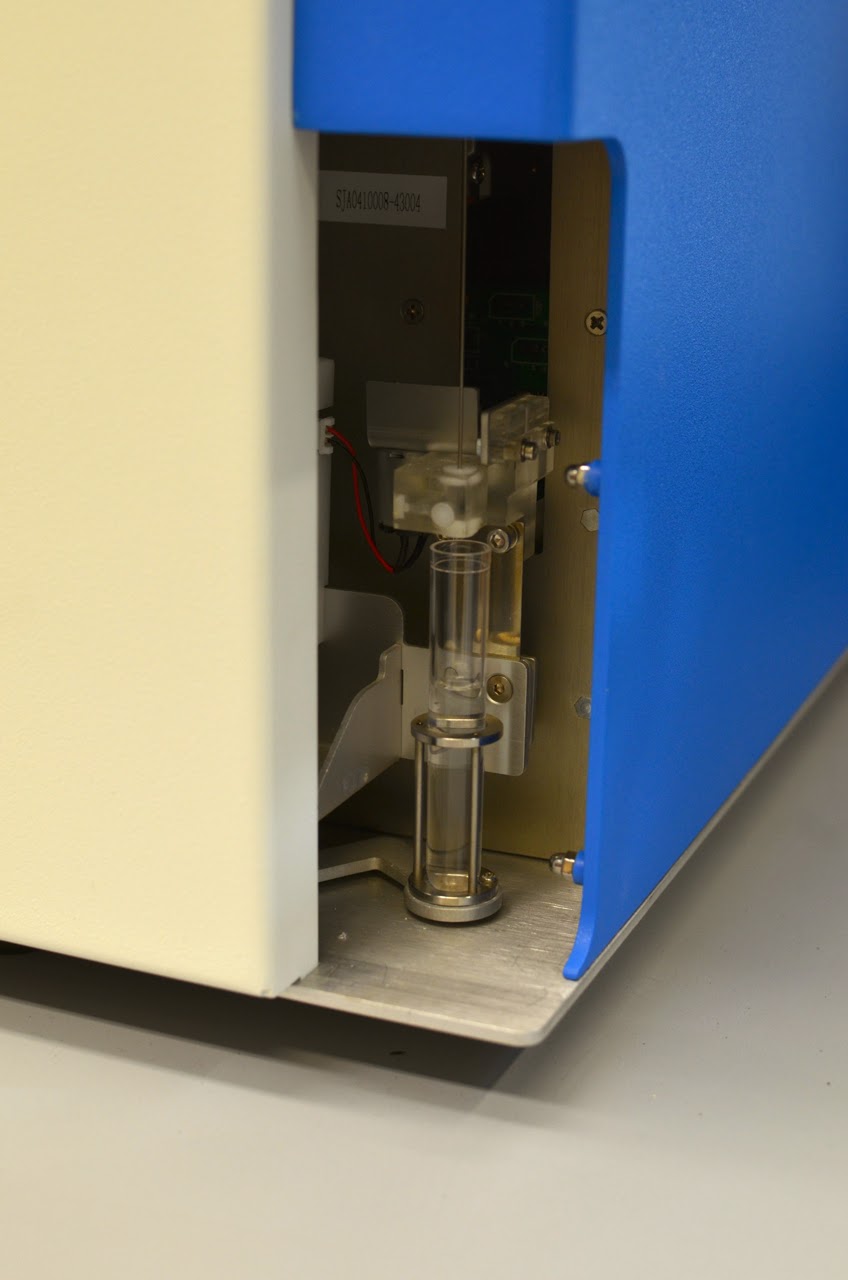 |
| Close-up of the sample tube loading arm. |
The sample loading stage is a bit funky at this point. The loading stage moves in and out with the smoothness of 20 grit sandpaper sliding across berber carpeting (i.e. not smooth at all). This loading/unloading operation slows down the process just enough to be annoying, but you get use to it after a while. No plate loader (yet), No multi-tube loader (yet).
Optics:
The optical system on the CytoFLEX is the biggest departure from any other instrument developed. A lot of the technology is proprietary, and as much information as I was able to deduce I'll share here, but I could be flat wrong on some things, so take what I say with a grain of salt.
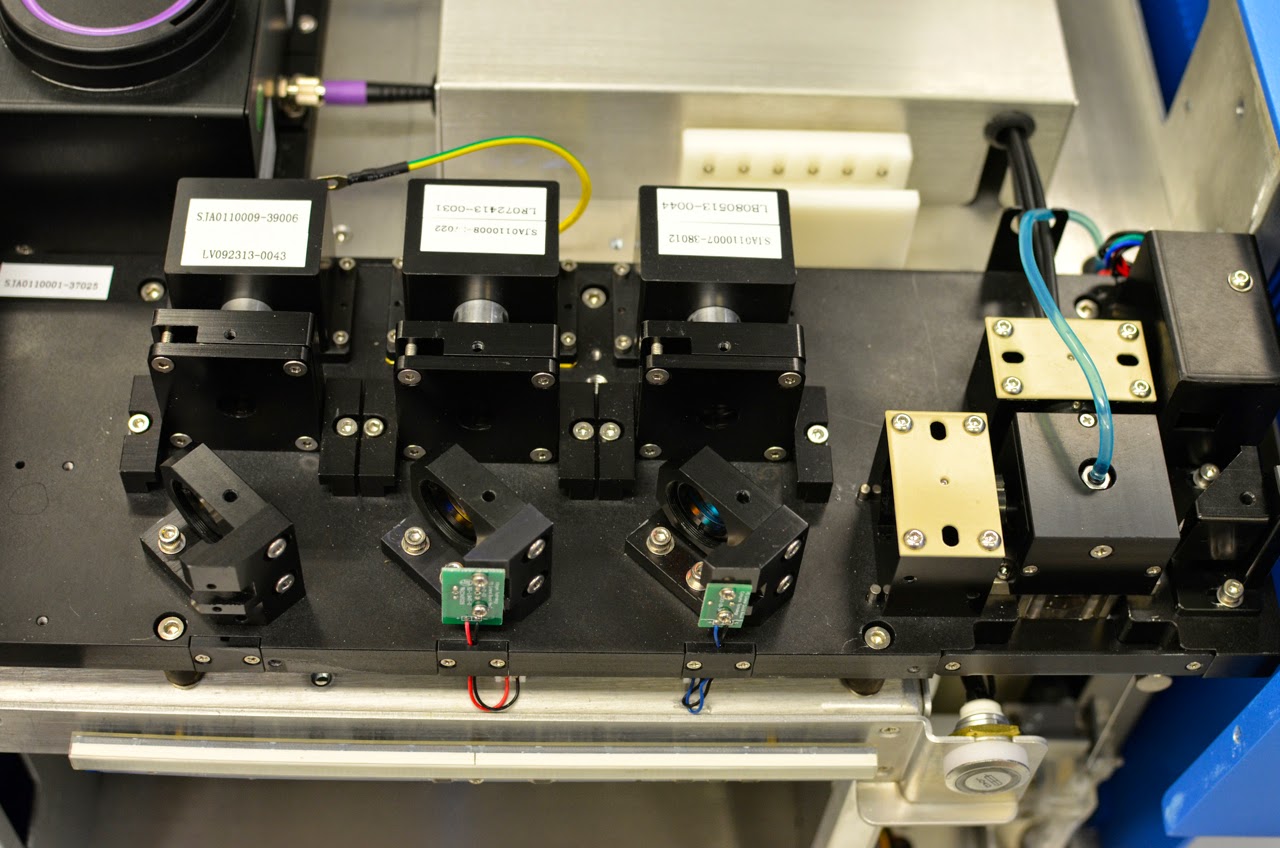 |
| Custom made Laser modules |
Emitted light is collected by fiber optic bundles which carry the light to the detector blocks. The detector blocks, referred to as Fiber Array Photo Detector Modules or FAPDs is where all the innovation takes place. The first thing you'll notice when looking inside the FAPDs is the small size of the filter sticks. Pulling one out reveals a tiny piece of glass no more than a few millimeters square. However, the rest of the components inside the FAPD are completely foreign to someone who's looked at dichroics, bandpasses, and PMTs his whole cytometry life. The light exiting the fiber passes through a wavelength division multiplexer, which acts like conventional dichroics to partially
split the light into distinct ranges, and then the light is further refined by the bandpass filters before hitting the photodiode. Photodiode? Don't you mean PMT? No, you read that right, this system uses Avalanche Photodiodes (APDs). These semiconductor detectors are well-known for their high sensitivity, and silicon based APDs have good quantum efficiency in the visible and near-IR range as well as low noise. If they're so sensitive why haven't they been used before? Good question, and as far as I can tell, the problem has always been the amount of voltage that needs to be applied to achieve high sensitivity and this high voltage causing breakdown of the APD. Somehow, this has been circumvented in the CytoFLEX. The other interesting thing about the detectors is that the response of the APDs across the entire range is absolutely linear. They stand by this fact so much so that if you set up compensation on FITC vs. PE at one set of voltages, and then change the voltages, the system will automatically adjust the compensation values to take into account the new voltage settings. This can only happen if the response is linear from end-to-end and therefore compensation is merely a mathematical equation with voltages as one of the variables.
 |
| Looking into the FAPD with a filter stick removed. |
Electronics:
The system uses 16-bit A/D converters and boasts of 7-decades of dynamic range. Normally 16-bits doesn't get you that much range, but by oversampling the pulses at 40MHz, and adding up all the samples, a full 7-log scale can be achieved. However, like most of these large scales, the first decade tends to exhibit poor resolution and is "hidden" by default. So the scale goes from 10^2 up to 10^7. Qualitatively, I will say that I was able to resolve all 8-peaks of the 8-peak rainbow bead set with some room on both sides of peaks 1 and 8 - that doesn't always happen.
One of the only complaints I had about this instrument was the loss of data at moderate to high event rates. This has to be due to the pulse processing speed of the electronics system and its inability to process the signals fast enough. It's likely influenced by sample concentration and the system's dynamic integration window - not unlike the FACSDiVa window extension setting. If the window is reduced, % abort would likely decrease. Also, increasing the threshold would also have the effect of better resolution between pulses and thereby decrease the abort rate. I did not explore either of these options when running and just used the default window extension and threshold. As you can see from the chart, even going at a moderate rate of 10,000 events per second yields an alarming abort rate. Going even faster results in a recovery of 50% or less. It's important to separate your ideas about % aborts on analyzers from high-speed sorters. Cell sorters have the advantage of pushing the cells through at very high velocities resulting is narrower pulses and an easier time resolving two closely related pulses. But, on analyzers, the cell velocity is much slower, resulting is broad pulses and more difficulty resolving closely related pulses. Therefore, the abort rates are typically going to be higher on slow flow analyzers, however we're not as aware of these abort rates on analyzers because we are
always only concerned with frequencies of populations and not absolute yield of populations (like on cell sorters). So, 10% abort over 20,000 events per second might be reasonable, however, 10% abort rates over 10,000 eps is probably not.
For this test, I created a concentrated sample using a suspension cell line, which, at 60ul/min should yield 50,000 events per second. I then created serial dilutions from there all the way down until an expected 2,500 events per second. I ran each tube on the instrument and recorded the event rate displayed by the system's counters.
always only concerned with frequencies of populations and not absolute yield of populations (like on cell sorters). So, 10% abort over 20,000 events per second might be reasonable, however, 10% abort rates over 10,000 eps is probably not.
Software/Interface:
If you've used CellQuest and FACSDiVa in your cytometry lifetime, you'll feel right at home here. There's not much to say about the software except that it works. It was super easy for me to pick up. I was shown nothing as far as how to operate the instrument, do compensation, etc... and I was able to figure it out with minimal struggle. The CytExpert software does one thing really well and that is it gives you a large, unobstructed view of your data, and just enough controls in a thin side panel to allow you to acquire data. I'm sure there are some analysis tools built in, but I don't care, I just want to acquire data, dump it into FlowJo and worry about analysis later. It gives you the ability to do automated compensation, use biexponential display, perform gating, and show stats windows. It would be interesting to see if something like Kaluza-G would ever make it onto something like this. But then again, Beckman Coulter already has 900 acquisition softwares already, what's one more!
Performance:
Finally the good stuff. What can I say, this thing rocks. In terms of fluorescence sensitivity, it beat the pants off of anything I've ever tested full stop. I've put a range of values together for fluorescence resolution that shows the spread of instruments I've tested. The value (called qNORM) represents the lowest number of antibodies bound that can be resolved from unstained lymphocytes. The lower the value, the better, and as you can see, the CytoFLEX, with its APD detectors and DIY lasers easily beats the average across the board. Of course I ran all the other common bead sets on this instrument. Everything I threw at it, it handled with ease.
8-Peak Resolution at low and high flow rates:
As you can see, resolving 8-peak beads is a cinch on the CytoFLEX pretty much across all channels. Even at the highest flow rate (240ul/min) the fluorescence resolution remains relatively unchanged, however the light scatter experiences some funky spread at the high flow rate.
APD Voltage Optimization:
Using a blank bead, the voltage was moved up and down the scale at appropriate intervals. The rCV was calculated on the single bead peak in each of the fluorescence channels. Using a similar test as PMT optimization, I wanted to see if the APDs behaved in a similar way. It does appear that there is a sweet spot for APD voltages that vary across parameters. This mimics PMT optimization profiles commonly seen before.
Linearity:
A pretty simple linearity test using PI stained CENs, and everything checks out as expected. However, like I mentioned earlier, linearity on this instrument has a bigger role on this instrument than others. With the CytExpert software, you can setup compensation at one set of voltages, change voltages (because it's a different cell line, or the sample is too bright, or other reason), and it will recalculate compensation based on the new voltages. This may have been (or may still be) part of the FACSVerse software, but I've never used one of those, so I'm not sure about that. Theoretically, then, you could create a set of comp tubes using non-tandem antibodies once, and then recall those comps each time, even if you've changed voltages. Anywho, linearity is great, it deviates from the theoretical line by less than 1% across the board.
 |
| PI Stained CENs comparing the theoretical line and the actual data |
qNORM Resolution Comparison:
Without going to much into the methodology (because I've done it so many times before), what follows is a comparison of pretty much every instrument I've ever tested (grey boxes with quartile whiskers) with the CytoFLEX (blue circles) overlain. This metric measures the number of bound antibodies that can be resolved from unstained lymphocytes. So, lower numbers equals better low-end resolution. As you can see the CytoFLEX compares very well with all the best instruments out there. It definitely beats every instrument I own in the FITC, PE, PECy7, and APC channels. In the PacBlue channel, it's about average. I'm pretty sure this system can resolve pretty much any dim population you can throw at it.
Final Thoughts:
It's evident to me that the CytoFLEX would suit the needs of many demanding applications. There's really no questioning its performance in terms of fluorescence detection. Light scatter resolution of cell populations wasn't as good as some of my better instruments. However, small particle detection, especially using 405nm side scatter is reported to give <200nm resolution. I typically don't test small particle stuff since it's not really my thing. The fluidics seemed stable and robust for the time I had it. I ran as many cell samples as I could to see if I could clog it up or make things look bad, and other than the high abort rates at high event rates, I saw no issues from a fluidics standpoint. The software is fine for what it needs to do. I'm so entrenched in doing analysis in FlowJo that I couldn't care less if there are histogram overlays or other fancy analysis-only plots in my acquisition software. I just want it to be fast and simple to use.
We also don't really know about the long term reliability of the hardware components. Sure everything works fine over the course of a month, but what about a couple years or more. Will it have the staying power and uptime of a FACScan? This, I'm afraid, only time will tell.
But, I think the most important take home message here is that this instrument proves that flow cytometry hardware is absolutely a commodity in the eye of the consumer. As fancy as one wants to make hardware these days, no one is going to be impressed. And the fact that hardware can be made cheaply reinforces this fact. What this means is that we'll finally see a shift in focus away from over-engineered hardware to hardware that just works, but this time with a super slick user interface that people are attracted to. The future is all about software and services, and I, for one, couldn't be happier!
Postscript: At the time of publishing, Beckman Coulter launched a new splash page with specs and a glimpse of the new exterior of the CytoFLEX. You can reach that page here.


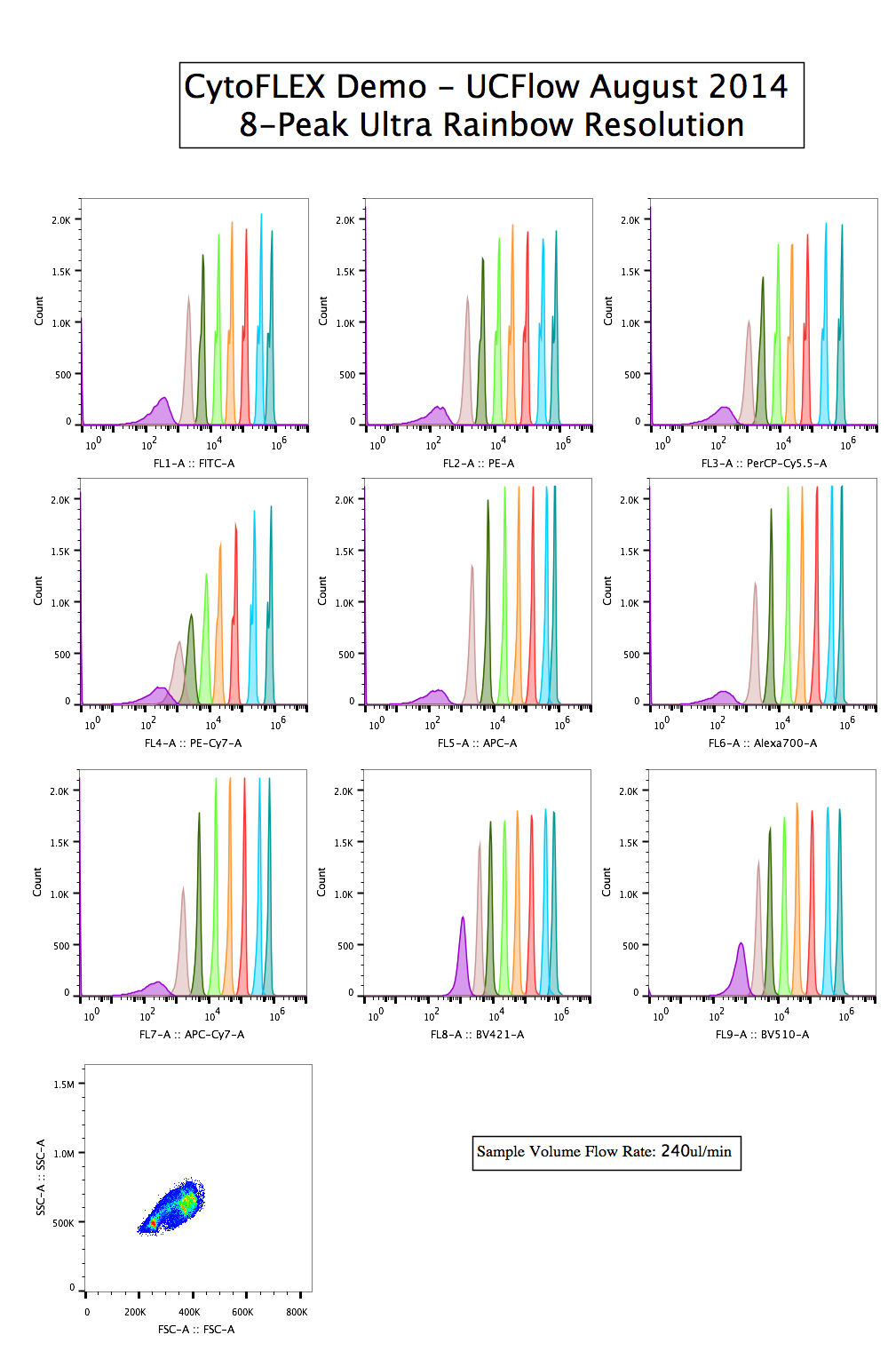
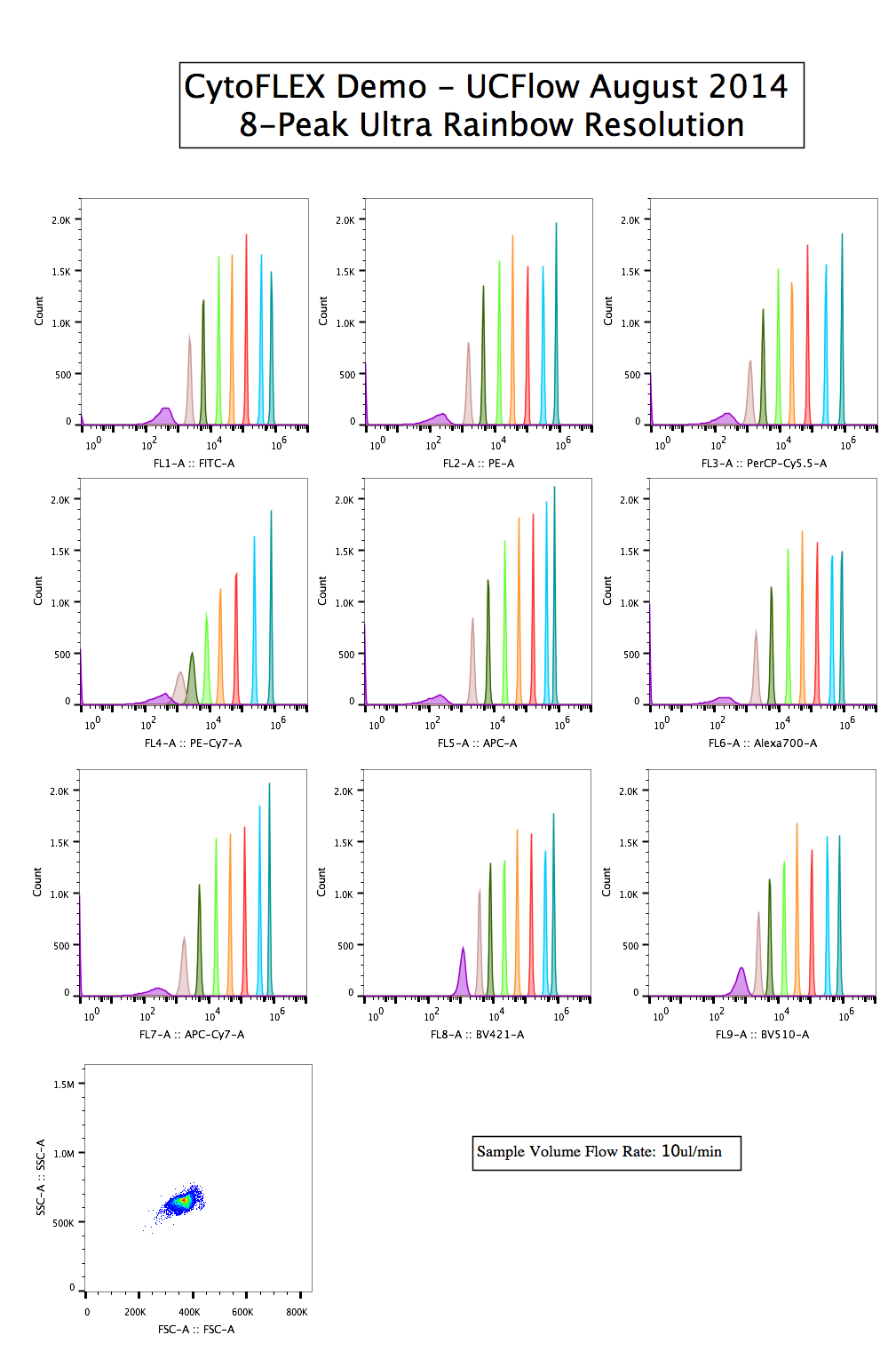



Do you know how they define an RFU?
ReplyDeleteUcflow - Flow Cytometry News, Reviews, And Tips.: A First Look At The Beckman Coulter Cytoflex - Strong Performance In A Small Box >>>>> Download Now
ReplyDelete>>>>> Download Full
Ucflow - Flow Cytometry News, Reviews, And Tips.: A First Look At The Beckman Coulter Cytoflex - Strong Performance In A Small Box >>>>> Download LINK
>>>>> Download Now
Ucflow - Flow Cytometry News, Reviews, And Tips.: A First Look At The Beckman Coulter Cytoflex - Strong Performance In A Small Box >>>>> Download Full
>>>>> Download LINK
Very thoughtfful blog
ReplyDelete